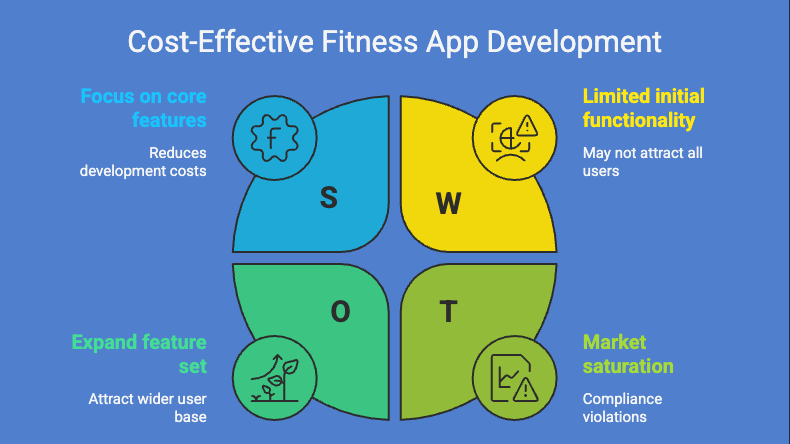Building a fitness app is like hiring a personal trainer—it’s an investment that pays off with the right plan. Fitness app development cost varies, but our roadmap breaks it down to help you launch a winning app. Whether you’re creating a simple tracker, a workout hub, or an AI-powered coaching platform, you need a clear cost estimate to compete in a market with 7.2 billion smartphones globally. Apps like Nike Training Club have set the bar high, blending seamless UX with cutting-edge features—yours can too.
We’ll guide you through how much it costs to build a fitness app, from features to budgeting tips, ensuring your investment delivers ROI. LITSLINK’s built user-loved apps—our cost guide is your path to a fitness app that transforms lives and leads the market. Ready to make your mark in 2025?
What Drives Fitness App Costs? The Basics
How much does it cost to make a fitness app? In 2025, the cost ranges from $25K for a basic tracker to $500K+ for an AI-driven coaching platform—it all depends on features, tech, and team. With 25 million fitness app users globally, understanding these cost drivers is your first step to budgeting a winning app like Fitbit or Peloton. Here’s what shapes fitness software pricing and why a clear plan matters.
Key Cost Drivers
- App Type: Simple trackers (e.g., step counters) cost less than virtual coaching apps with live sessions or AR workouts.
- Features: Basic tracking is cheaper than advanced additions like AI analytics, wearable integration, or video streaming.
- Compliance: Regulations like HIPAA or GDPR add up to 40% to budgets for secure data handling.
- Team Size: Larger teams or specialized roles (e.g., AI engineers) increase costs but ensure quality.
A clear fitness app development cost plan avoids budget overruns that derail projects. By mapping features and scope early, you’ll invest wisely to compete in a booming market. Ready to crunch the numbers for your 2025 fitness app?
Cost Breakdown by App Type: 2025 Estimates
Fitness app development cost varies widely depending on the type of app you’re building—$25K for a basic tracker or $1M for an enterprise wellness platform. With 25 million fitness app users globally, knowing how much it costs to build a fitness app by type helps you budget smart and compete with giants like Fitbit or Peloton.
This breakdown details four common fitness app types—Tracker, Workout, Coaching, and Enterprise Wellness—with cost ranges, key features, and development timelines to guide your investment.
App Type |
Cost Range |
Key Features |
Timeframe |
| Tracker | $25K-$80K | Step counters, calorie tracking, basic UX. | 3-6 months |
| Workout | $50K-$150K | Pre-recorded workouts, progress logs, social sharing. | 6-9 months |
| Coaching | $100K-$300K | Live sessions, AI personalization, video streaming. | 9-12 months |
| Enterprise Wellness | $300K-$1M | Corporate wellness, multi-user integration, analytics. | 12-18 months |
Tracker Apps
Tracker apps, like Fitbit, focus on simplicity—step counters, calorie tracking, and basic UX. These cost $25K-$80K due to lightweight features and minimal backend needs. Development takes 3-6 months, using tools like Flutter for cross-platform builds. With users wanting basic tracking , they’re a low-cost entry point. Budget for wearables integration ($5K-$10K) to boost appeal. Fitness app development cost for trackers is affordable, ideal for startups aiming to capture casual fitness fans.
Workout Apps
Workout apps, like Nike Training Club, offer pre-recorded workouts, progress logs, and social sharing, costing $50K-$150K. Development spans 6-9 months, needing robust UI and content management systems. Features like workout libraries add $15K-$40K, per fitness software pricing trends.
With users seeking guided exercises, these apps balance cost and engagement. Plan for cloud hosting ($1K-$5K/month) for smooth streaming. The cost to develop a fitness app here suits mid-tier projects with growth potential.
Coaching Apps
Coaching apps, like Peloton, deliver live sessions, AI personalization, and video streaming, costing $100K-$300K. Development takes 9-12 months due to complex backends and real-time features. AI coaching adds $40K-$100K, but cuts churn.
With 91% of users craving a personalized experience, these apps drive loyalty. Budget for scalability ($10K-$50K) to handle user spikes. The cost to make a fitness app at this level targets premium markets with high ROI potential. Find out how AI has been used in the Olympic Games, improving athletic results and boosting the viewers’ experience.
Enterprise Wellness Apps
Enterprise wellness apps, like Virgin Pulse, support corporate programs with multi-user integration and analytics, costing $300K-$1M. Development spans 12-18 months, requiring HIPAA-compliant systems and complex dashboards. With 69% of employers investing in wellness, these apps attract B2B deals. Compliance costs $20K-$50K, per fitness app development cost norms. Plan for ongoing maintenance ($50K-$200K/year) for multi-client support. The cost to develop a fitness app fits large organizations aiming for market leadership.
Knowing fitness app development cost by type sharpens your budget—IT companies run 45% of projects over budget. Whether you’re building a tracker or an enterprise platform, this guide ensures your 2025 investment delivers a user-loved fitness app that stands out.
Key Features & Their Costs: A Comparison
Fitness software pricing depends on the features you prioritize. To help you navigate the cost, we’ve compared five core features—Tracking, Workouts, Live Coaching, AI Analytics, and Wearable Integration—with their cost ranges and complexity.
This guide ensures your app, whether a simple tracker or a Peloton-style platform, delivers value in a 25-million-user market.
Feature |
Cost Range |
Complexity |
| Tracking | $5K-$20K | Simple: Step counters, calorie logs, basic metrics. |
| Workouts | $15K-$40K | Moderate: Pre-recorded videos, progress tracking, social sharing. |
| Live Coaching | $30K-$80K | High: Real-time video, chat, scheduling systems. |
| AI Analytics | $40K-$100K | Complex: Personalized plans, predictive insights, fraud detection. |
| Wearable Integration | $20K-$60K | Moderate: Sync with Apple Watch, Fitbit, heart rate monitors. |
Why These Features Matter
- Tracking: The backbone of apps like Fitbit, tracking steps and calories, is low-cost and quick to build, using basic APIs. Users want simple metrics.
- Workouts: Pre-recorded workout videos, like Nike Training Club, require content systems and UX design, adding moderate costs. They boost engagement, with users seeking guided exercises.
- Live Coaching: Real-time sessions, like Peloton’s, demand robust streaming and scheduling tech, increasing complexity. They drive loyalty, cutting churn.
- AI Analytics: AI-driven plans, like adaptive coaching, are pricier but transformative—92% of businesses use AI for personalization.
- Wearable Integration: Syncing with Apple Watch or Fitbit adds moderate costs but is critical, as 40% of users rely on wearables.
Why It Helps
Picking features for fitness apps shapes your budget and user experience. A tracker app needs basic tracking to launch fast, while AI analytics can differentiate a coaching app, but inflate costs. Without clarity, apps overspend, risking failure.
Use this table to align features with your goals—whether competing with Fitbit’s simplicity or Peloton’s premium feel. So, how much does it cost to make a fitness app? It depends on these choices, but a smart feature mix ensures your app delivers ROI and wins users in a competitive market.
Hidden Costs You Can’t Ignore
Beyond core development, fitness app development cost includes sneaky expenses that catch app projects off guard. From compliance to marketing, these costs are critical to plan for to ensure your tracker, coaching, or wellness app competes with Fitbit or Peloton. We’ll help you dodge them with this breakdown to keep your investment on track.
Compliance
- Cost: $10K-$50K upfront for HIPAA, GDPR, or CCPA compliance.
- Why It Matters: Fitness apps handling health data, like a wellness platform tracking biometrics, must meet strict regulations to avoid $100K fines.
- Example: A coaching app needs HIPAA-compliant servers to store user workout logs securely.
- Tip: Budget for legal audits early to prevent costly rework.
Security
- Cost: 15% of total budget—$5K-$75K—to prevent data breaches.
- Why It Matters: Encryption, secure APIs, and penetration testing are non-negotiable—45% of users ditch apps after breaches.
- Example: A tracker app syncing with wearables needs end-to-end encryption to protect step counts and heart rate data.
- Tip: Invest in regular security audits to maintain trust.
Maintenance
- Cost: 15-25% of build cost yearly—$5K-$125K to keep apps functional.
- Why It Matters: Updates for iOS/Android, bug fixes, and feature tweaks are ongoing—apps fail to be competitive without maintenance.
- Example: A workout app must update workout libraries to retain users post-launch.
- Tip: Plan for a maintenance team to ensure 99.9% uptime.
Scalability
- Cost: $1K-$50K/month for cloud upgrades to handle 10x user spikes.
- Why It Matters: Viral growth, like a coaching app trending during New Year’s resolutions, demands scalable infrastructure.
- Example: A tracker app needs AWS scaling to support a sudden 100K-user surge.
- Tip: Use cloud platforms like AWS or Firebase for cost-efficient scaling.
Marketing
- Cost: $5K-$50K for app store optimization (ASO) and ads to drive downloads.
- Why It Matters: Even great apps flop without visibility—fitness apps get more downloads with marketing.
- Tip: Budget for ASO and social campaigns to boost discoverability.
Hidden costs in fitness app development can inflate budgets if ignored. Planning for compliance, security, maintenance, scalability, and marketing ensures your app thrives in 2025’s competitive fitness market.
How to Save on Fitness App Costs: Smart Strategies
In a 25-million-user fitness app market, launching a tracker, workout, or coaching app doesn’t have to break the bank. Fitness app development cost can range from $25K to $1M, but smart strategies can slash the price while delivering a user-loved product that rivals Fitbit or Peloton.
These four cost-saving tactics will keep your 2025 budget lean and your app competitive. Use these strategies to save smart and launch big.

Strategy 1: Start with an MVP
- How It Saves: Building a Minimum Viable Product (MVP) with core features like step tracking or basic workouts cuts the cost to develop a fitness app.
- Example: Launch a tracker app with step counters and calorie logs, then add AI coaching in version two.
- Impact: An MVP tests market fit fast—87.9% of businesses state that MVP helps to validate the business idea.
- Tip: Prioritize one killer feature to hook users without bloating costs.
Strategy 2: Use Low-Code & Cloud Platforms
- How It Saves: Low-code platforms like Bubble and cloud services like AWS or Firebase reduce development time and hosting costs.
- Example: A workout app uses Firebase for scalable storage of workout videos, avoiding costly custom servers.
- Impact: Cloud platforms handle 10x user spikes efficiently, saving $1K-$50K/month.
- Tip: Choose low-code for rapid prototyping and cloud for long-term savings.
Strategy 3: Outsource Strategically
- How It Saves: Offshore or nearshore teams cut costs compared to in-house development, without sacrificing quality.
- Example: A coaching app outsources to Eastern Europe for AI expertise at half the U.S. rates.
- Impact: Strategic app development outsourcing delivers faster timelines—crucial for beating competitors.
- Tip: Vet teams for fitness app experience and Agile workflows to ensure efficiency.
Strategy 4: Plan Compliance Early
- How It Saves: Early HIPAA or GDPR audits avoid rework costs that hit non-compliant apps.
- Example: A wellness app budgets $10K upfront for HIPAA compliance, dodging $100K fines later.
- Impact: Proactive compliance builds user trust—90% of users prioritize data safety.
- Tip: Hire a compliance consultant during planning to streamline certification.
These strategies make fitness app development cost-effective, ensuring your app launches on budget and thrives in the competitive market. How much does it cost to make a fitness app? Less when you plan smart—MVPs, low-code, outsourcing, and early compliance let you invest wisely while delivering a tracker or coaching app users love. You can get an estimate for your future fitness app development with our free cost calculator. Just answer a few questions, and you’ll get the results.
Timeline: From Idea to Launch in 2025
Whether building a simple tracker or a Peloton-style coaching app, the cost to build a fitness app ties directly to development phases and duration. Poor planning causes project delays, derails budgets, and hinders market entry. This timeline outlines four key phases—Planning, Development, Testing, and Launch & Maintenance—to ensure your app hits the market on time and thrives.
Planning (1-2 months)
- Define features (e.g., step tracking, AI coaching), compliance needs (HIPAA), and budget. For a workout app, map workout libraries and UX flows. This phase sets the scope, avoiding scope creep.
Development (3-12 months)
- Code features and integrate tech—simple trackers take 3-6 months, coaching apps with live streaming need 9-12. A tracker app uses Flutter for quick builds, while AI apps require complex backends. Keep in mind that agile sprints cut delays.
Testing (1-3 months)
- Stress-test for 10K users and ensure 99.9% uptime. For a coaching app, test video streaming across devices. Rigorous testing prevents post-launch crashes.
Launch & Maintenance (Ongoing)
- Deploy on AWS and monitor with Datadog to retain users. A wellness app tracks New Year’s user spikes. Ongoing updates ensure compliance and engagement.
A clear timeline aligns fitness app development cost with your goals, preventing costly delays. Plan now to launch a user-loved app that competes with Fitbit or Peloton.
ROI: Why Your Investment Pays Off
Investing in a fitness app in 2025 is a bold move in a 25-million-user market generating $289.17 billion annually. A smart fitness app development costs fuel revenue, user growth, and a market edge. Whether you’re launching a tracker or a Peloton-style coaching app, here’s why your investment in fitness software pricing pays off big. LITSLINK’s built apps with high ROI—invest wisely to lead in 2025.
Revenue Streams
- Subscriptions & In-App Purchases: Premium features like personalized coaching drive $10-$50/month per user—most fitness app revenue comes from subscriptions.
- Corporate Partnerships: Wellness apps attract B2B deals, with employers investing in employee fitness programs.
- Example: A coaching app’s subscription model mirrors Peloton’s, generating millions annually.
User Growth
- Retention: Quality UX, like seamless workout tracking, boosts user retention, increasing lifetime value.
- Example: A tracker app’s intuitive design keeps users logging daily, driving ad or upgrade revenue.
Market Edge
- Competitive Features: AI coaching and AR workouts cut churn, positioning your app against Fitbit.
- Example: An AI-driven app personalizes plans, winning more users than generic trackers.
A strategic fitness app development delivers exponential returns by tapping into subscriptions, partnerships, and loyal users.
Conclusion: Budget Right, Build Big
Fitness app development cost ranges from $25K for a simple tracker to $1M for an enterprise wellness platform, but our guide equips you to budget smart and win a 25-million-user market. We’ve detailed costs by app type, from trackers to coaching apps, broken down key features like AI analytics, and revealed hidden costs like compliance to avoid budget overruns.
Our savings strategies—MVPs, low-code, and outsourcing—cut the cost to develop a fitness app, while timelines and ROI insights ensure your investment delivers returns. A smart fitness app development fuels apps like Peloton, transforming fitness and driving revenue. Ready to launch? LITSLINK’s mastered fitness app development —let’s build your app to lead the market and inspire millions!





